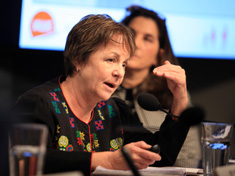-
Reproductive Health Care in Crises Has Come a Long Way, Says Sandra Krause, But There’s More to Be Done
December 23, 2016 By Sean Peoples There may be more women and girls at risk of maternal health complications in fragile and conflict-affected settings today, but attention to the issue is not new and the international community has made important strides over the last 20 years, says Sandra Krause, program director for reproductive health at Women’s Refugee Commission, in this week’s podcast.
There may be more women and girls at risk of maternal health complications in fragile and conflict-affected settings today, but attention to the issue is not new and the international community has made important strides over the last 20 years, says Sandra Krause, program director for reproductive health at Women’s Refugee Commission, in this week’s podcast.There may be more women and girls at risk of maternal health complications in fragile and conflict-affected settings today, but attention to the issue is not new and the international community has made important strides over the last 20 years, says Sandra Krause, program director for reproductive health at Women’s Refugee Commission, in this week’s podcast.
The rights of refugees and internally displaced persons to reproductive health were first widely recognized by governments in 1994 at the International Conference on Population and Development in Cairo, she says.
That formal recognition sparked the creation of Inter-Agency Working Group on Reproductive Health in Crisis (IWAG) a year later to build a set of guidelines and best practices for sexual and reproductive health care in crisis contexts. “In those guidelines,” Krause says, “it established a set of priority interventions to be put in place at the same time humanitarian actors were trying to meet basic and survival needs and prevent infectious diseases.”
“It’s consistently a gap in almost every humanitarian emergency I go to”The widespread recognition of these standards was central to improving care for women and children around the world, according to Krause. “There were to be these coordinated activities to prevent excess maternal and newborn mortality, to prevent the transmission of HIV, and to address sexual violence.”
One of the tools created by the IWAG is the Minimum Initial Service Package, or MISP. The MISP is a practical guide for disaster and humanitarian response workers to help them prevent and appropriately respond to sexual violence, address maternal and newborn health, reduce HIV transmission, and plan for the eventual resumption of full health services.
Thanks to these efforts, “the capacity to address reproductive health and crisis has increased,” says Krause. “Development agencies have jumped in to participate in humanitarian relief and that’s helped quite a bit.” Sixty-eight percent of development agencies report they have an internal policy or mandate for reproductive health in humanitarian emergencies, and funding for reproductive health increased 298 percent between 2002 and 2011, Krause says.
Yet, clearly, as demonstrated by the dire situations in Syria, South Sudan, and elsewhere, gaps remain. Overall, conflict-affected countries receive almost 60 percent less official development assistance for reproductive health than non-conflict affected countries, says Krause. What money there is largely goes to “lower hanging fruit” – things like nutrition programs – but not as much to “life-saving emergency obstetric and newborn care that’s so critical and probably more costly as well.”
One of the most glaring needs illustrated by several evaluations is clinical care for survivors of sexual assault. “It’s consistently a gap in almost every humanitarian emergency I go to,” Krause says. “It’s not a difficult intervention, but you have to have the protocol and then you need nurses, doctors, midwives, and people trained in it.”
Sandra Krause spoke at the Wilson Center on December 8, 2016.
Friday Podcasts are also available for download on iTunes and Google Play.
 A Publication of the Stimson Center.
A Publication of the Stimson Center.

 There may be
There may be 

